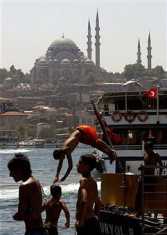By David O’Byrne of business new europe
 With his party expected to win its third overall majority in general elections on June 12, Tayyip Erdogan, Turky’s prime minister, seems set on establishing his own legacy with his long-promised “crazy project” finally unveiled this week: a 50-kilometre long, 120-metre wide canal that his government plans to construct 100 km west of Istanbul between the Black Sea and the Sea of Marmara.
With his party expected to win its third overall majority in general elections on June 12, Tayyip Erdogan, Turky’s prime minister, seems set on establishing his own legacy with his long-promised “crazy project” finally unveiled this week: a 50-kilometre long, 120-metre wide canal that his government plans to construct 100 km west of Istanbul between the Black Sea and the Sea of Marmara.
Wide and deep enough for supertankers of up to 300,000 deadweight tonnage – bigger than the biggest tankers in use today – the canal will have no locks and will use passing places and a mooring basin midway to allow simultaneous traffic in both directions – in contrast to the dangerously overcrowded Bosphorus strait, which must be closed in both directions to allow the largest tankers through.
The aim is simple. With oil production in the Caspian region expected to double to around 40m tonnes over the next decade, the number of tankers using the Bosphorus is also expected to double from a current average of 27 a day – a volume of traffic that threatens to overload the strait and expose Istanbul to an environmental disaster in the event of an accident.
The new canal would reduce traffic through the Bosphorus and – with none of the twists and turns of its natural neighbour – offer a safer and quicker route.
That aim in itself is not new. Turkey has for years been backing a project to bypass the Bosphorus: the Samsun Ceyhan pipeline, sponsored by a consortium of Turkey’s Calik Energy and Eni, which would link the Black Sea with the Mediterranean.
People close to the project told bne that the Samsum-Ceyhan pipeline remains firmly on the agenda, as the Turkish government expects Caspian oil production to grow enough to justify both the pipeline and the canal. But with Turkey obliged by the 1936 Montreux convention to allow free passage through the Bosphorus, Samsun-Ceyhan has so far failed to secure commitments of sufficient oil to ensure its viability.
“The same problem applies to a canal as to a pipeline – if one is free and one has a tariff, then there has to be a group agreement between oil shippers as to how much oil they send through each,” says John Roberts, Caspian specialist at Platts, an energy consultancy. “The only alternative is to renegotiate the Montreux treaty, which Russia for one would not be open to.”
The people close to the project told bne that Ankara does indeed hope to renegotiate Montreux, despite the expected difficulties. But with Russia having apparently gone back on its promise to provide oil for Samsun-Ceyhan, many are viewing the canal as a bargaining ploy to pressure Moscow to moderate its demands for a majority stake in the pipeline – albeit one that doubles as a handy pre-election stunt.
Nevertheless, many find the boldness of the project compelling, although many too question the rather low $10bn cost estimate.
“As a logistics engineer, I think it’s a great idea,” says Ergin Buyukbayram, a logistics consultant who last year produced a major report on logistics in Turkey. “But it will be very difficult to build and will cost a lot more than they predict – maybe $20bn-25bn at least.”
With shippers unlikely to pay to use the canal while transit through the Bosphorus is free, Ankara plans to offset at least part of the cost by selling real estate along the canal banks. Erdogan has argued that continued migration to Istanbul calls for bold plans to expand the city.
Many remain unimpressed with that idea, pointing to the tens of thousands of unsold properties on out-of-town estates built in the bubble of property speculation that pre-dated the global economic crisis.
“Demand for out-of-town property is low because most jobs are inside the city, and transport links are abysmal,” says one Istanbul property developer, who reckons it would take a major sea change to persuade employers to move 100 km into Thrace.
And the historic precedent for such massive infrastructure projects is not encouraging.
The Panama Canal was only built at the second attempt after a massive financial scandal; the Manchester Ship Canal Company went bankrupt twice before a rescue by Manchester city council allowed ships to sail direct to the landlocked industrial city; early income from the Suez Canal was so low that it required the development of a new way of calculating tonnage to rack up transit fees.
All of which suggests that if Erdogan really does get his place in history, it may be the Turkish taxpayer who will foot the bill.
via Erdogan’s crazy plan unveiled | beyondbrics | News and views on emerging markets from the Financial Times – FT.com.

Leave a Reply